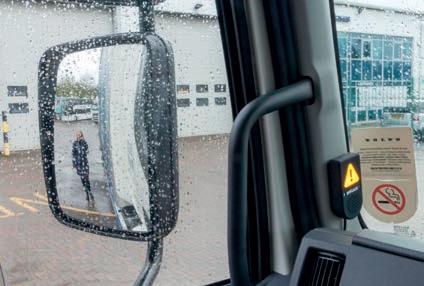
7 minute read
The eyes have it
Enforcement only began in March 2021, but can the Direct Vision Standard already be described as a success? Chris
One year after enforcement of the Direct Vision Standard (DVS) began, TfL was unequivocal in its belief of the scheme’s success: “Our world-first Direct Vision Standard has helped to dramatically improve the safety of lorries and save lives,” said Christine Calderto, director of transport strategy and policy.
Advertisement
So, how dramatic has the improvement been and is it still too soon to draw any conclusions about the role of the DVS in achieving this?
According to TfL, there were 17 serious injuries involving HGVs in 2021, down from 48 in 2017.
There were 11 fatal collisions involving HGVs and people walking or cycling; of these, six occurred where vision was cited as a contributing factor. TfL says this figure of six compares to eight in 2020 and nine in 2019.
In addition, of those six, four involved lorries that were rated zero under the DVS – ie the poorest direct vision for the driver from the cab (see box below) – which TfL says “demonstrates the value of direct vision over other safe system equipment.”
However, it is difficult to calculate how Covid has skewed the figures, if at all.
Emily Hardy, UK marketing manager at Brigade Electronics, thinks it has, but the impact is not yet obvious. “The DVS was implemented during the pandemic when traffic and pedestrian habits were altered, so it is difficult to obtain a clear picture,” she says.
Vision Of The Future
Tindall reports
ON YOUR BIKE: The popularity of cycling in London has increased significantly since the pandemic
“We saw a huge increase in cyclists and pedestrians on the road during this time and so in real terms rates have fallen.
“Serious injuries have also reduced dramatically. Ultimately the number of fatalities ‘where vision was cited as a contributing factor’ has reduced, which would indicate the scheme is working and that enforcement of direct vision and additional safety devices has made London streets safer for all.”
Industry assessment
The industry’s main trade associations were critical of the DVS in the run-up to permits being made available in 2019.
At the time, Logistics UK’s argument was that operators were already fully committed to improving road safety and so other strategies would deliver “a far greater outcome”.
The RHA pointed out that haulage needed coherent, consistent regulation, rather than “a patchwork of locally devised standards and permit systems which cause concern and confusion”.
That being so, both groups are curiously quiet in their thoughts about the DVS today. Logistics UK did not respond to requests for a comment and Chris Ashley, RHA policy lead, environment and vehicles, just says: “Road safety is everyone’s responsibility and we’re committed to promoting the highest safety standards in
Last month, TfL said it was consulting on plans to tighten up the DVS in 2024, in order to take into account the way technology has developed.
Currently, the minimum DVS rating for HGVs entering and operating in Greater London is one star. A vehicle can have a rating of zero stars – the lowest rating, with poor direct vision – right up to five stars and if your HGV is rated one to five stars, you can apply for a permit without the need to provide any additional evidence.
However, if your HGV is rated zero stars, the requirement is that you make your vehicle safer by fitting it with a “safe system”. These include mirrors, sensors and cameras designed to reduce the risks that trucks present to pedestrians and cyclists.
From October 2024, TfL wants to increase the minimum DVS rating from one to three stars and vehicles that are two stars or under will have to fit its “progressive” safe system, which will take into account new and emerging technology or safety equipment that was not available during the design of the current safe system.
TfL says moving to the new progressive system is “vital” to the Mayor’s efforts to meet its Vision Zero goal, an ambitious target that equates to eliminating all deaths and serious injuries from London’s transport network by 2041.
It is estimated that the new safety requirements will be applied to around 165,000 vehicles – 90% of the existing fleet operating in the capital.
The changes being consulted on include: updating guidance on the use of mirrors and camera monitoring systems (CMS); a requirement that CMS is fitted on vehicles to eliminate blind spots along the passenger side; the installation of sensors that detect vulnerable road users down the passenger side; the fitting of “moving off information systems” to the front of HGVs; and the fitting of audio warnings to all vehicles.
“Every death and serious injury on our roads is a tragedy and it’s clear that there is still more work to do, which is why TfL is now asking Londoners to have their say on the next phase of plans that would strengthen HGV safety measures even further,” says Will Norman, London’s walking and cycling commissioner.
TfL‘s spokeswoman adds: “DVS was always designed to be a progressive scheme and plans for future reviews of the star-rating threshold and the safe system have been made clear since the initial consultation. This was to ensure that TfL can continue to drive safety improvements while providing the industry with a pathway to meet these.” our industry. We will work with TfL on practical measures to improve road safety, such as the progressive safe system proposed from 2024.”



Ironically, the only detectable whiff of dissent was at British Cycling (BC), the governing body for cycling sport in Britain. Nick Chamberlain, BC policy manager, says: “Is DVS the ultimate solution to road danger reduction? Of course not, it is one of a package of measures that is needed to impact the horror of road deaths and serious injury.”
Chamberlain goes on: “I am comfortable that the statistics issued by TfL indicate a strong positive correlation between the enforcement of DVS and reduced danger on London’s roads, especially when serious injury as well as fatalities are considered.
“The Mayor’s Vision Zero strategy for London is based on globally recognised science and is a clear evidencebased package of measures that will, if fully enacted, save lives and change London’s roads and streets for the better.
“The needs of the haulage industry remain vitally important, but I am satisfied that the industry, based on talking to industry leaders and BC members who work in haulage, is being robustly engaged in the work and that their voice is heard and has influence on the decisions being made.”

Multiple initiatives
Inspector Rik Wenham is the Metropolitan Police’s lead officer for commercial vehicles in the capital and he says that “without a doubt”, the DVS has contributed towards reducing fatalities and serious injuries involving HGVs. However, he also says it is just one piece in a jigsaw and other initiatives are helping to reduce casualties too.
“In addition to the Direct Vision Standard, the introduction of low-entry cabs has had a significant impact,” he says. “While I am aware that some drivers did not like the Mercedes and Dennis Eagle cabs, advanced low-entry cabs from Scania and Volvo retain that ‘lorry’ feel, but put the driver that much lower and on the level of a cyclist or pedestrian.
“Driver training that companies are committed to prior to allowing contracts in the London area is also pivotal. Safer urban driving DCPC and putting a driver on a bike really is impactive and the immersive DCPC that Thames Tideway provides to all drivers on their contracts really does have an effect.
Distinguishing A Post From A Person
SAFETY FEATURES:
Mirrors and passenger-side sensors are elements of the safe system, which is mandatory on zero-star rated HGVs operating in London

One of the proposed changes to the DVS to be introduced in 2024 is that sensors fitted down the passenger side of an HGV must not be activated by roadside furniture or stationary vehicles.
Explaining this curious requirement, Richard Lane, commercial director at VisionTrack, says: “Traditional proximity sensors warn of a nearby road user, but often an alert can be triggered by railings or street furniture such as lampposts, bollards, road signs and bins.
“The risk here is that a driver becomes complacent and takes less notice of an alarm because it is often reacting to objects in close proximity, which can naturally occur, particularly in urban environments, but present no risk.
“To overcome this challenge, VisionTrack has developed an AI-powered side camera that can detect vulnerable road users (VRUs) such as pedestrians, cyclists, motorcyclists and people on scooters, while disregarding street furniture.
“Footage is automatically displayed on an in-cab monitor, and even supplemented with an audible, spoken warning with the precise location of nearby VRUs in relation to the vehicle. This keeps the driver more engaged by providing highly accurate and useful information.”
However, Lane adds that technology alone will not eliminate all vision-related incidents, something for TfL to think about as it strives for its Vision Zero goal.
“Road transport operators also need to take an active role in monitoring their fleet safety performance and identifying where driver risk exists,” he says. “It is only possible to achieve this level of visibility by adopting some form of connected camera solution, which enables them to analyse collisions, near misses and other driving events and then take steps to address any health and safety issues.”
“Being a C+E licence holder and having done both DCPC modules myself, they really have an impact and just prompt that moment of additional thought or that extra mirror check.”
And then there are the measures being taken by the industry, as well as ongoing research and development, regardless of the strict standards that exist.
“Everything from the positioning of mirrors and monitors to the shape of panels is considered,” Wenham says. “The commercial vehicle industry is as regulated as rail and aviation, the drivers are professionals and have to comply with additional training and medicals.
“It is testament to the professionals within the industry that fatalities have reduced. The London road infrastructure has changed significantly with the inclusion of cycle super highways and smart roadways with joint right of way – and there’s been more than a 200% increase in cycling since the pandemic. I’d say we are on track.”
What about the buses?
It was put to TfL that buses also kill and injure vulnerable road users and yet they already have excellent direct vision.
A TfL spokeswoman says it is determined to ensure the whole transport network is safer as part of its broader Vision Zero goal. “There are fewer than three injuries for every million journeys on London’s buses,” she says. “TfL’s bus safety programme continuously drives major safety improvements across its network and TfL funds specific interventions to reduce collisions and improve existing safety processes and data collection.”
The spokeswoman confirms that a cost/benefit analysis was conducted into the DVS and this showed “a strong case for further investment in the scheme”.
“A combined total of 14 fatal collisions occurred between 2020 and 2021 where vision was a factor, which is tragic and unacceptable,” she adds. “It also comes at an economic cost, which the DfT puts at £29.68m.” ■
















